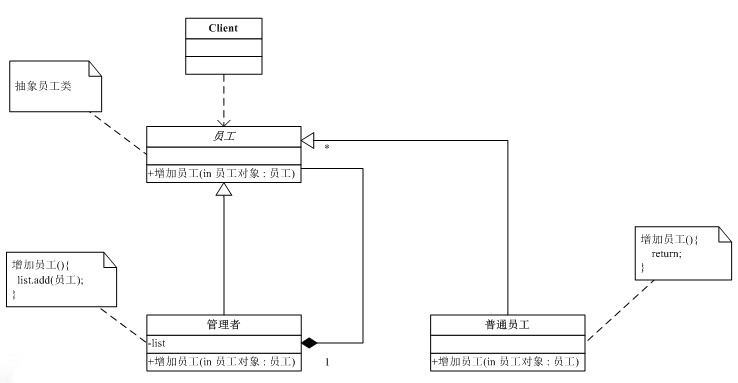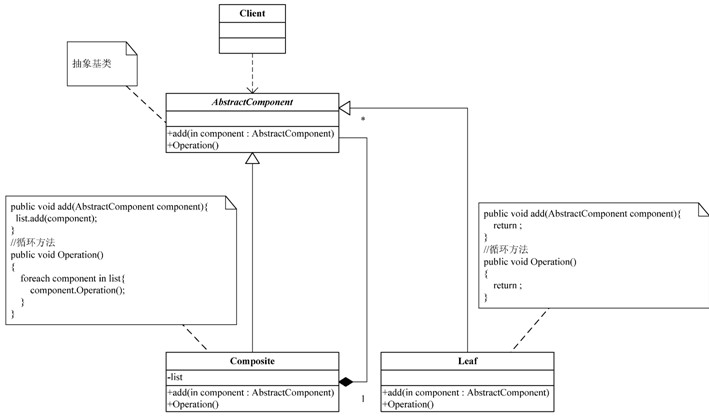您好,登錄后才能下訂單哦!
您好,登錄后才能下訂單哦!
怎么在Java中利用組合模式實現公司組織結構功能?相信很多沒有經驗的人對此束手無策,為此本文總結了問題出現的原因和解決方法,通過這篇文章希望你能解決這個問題。
一、模式定義
組合模式:將對象組合成樹形結構以表示“部分一整體”的層次結構,組合模式使得用戶對單個對象和組合對象的使用具有一致性。
二、組合模式舉例
1 模式分析
我們借用公司組織結構圖來說明這一模式。
經過分析后,我們得出該模式靜態類圖如下:

2 代碼示例
2.1 建立員工抽象類
package com.demo.composite;
/**
* 職工類接口
*
* @author
*
*/
public abstract class Staff {
// 員工號
protected String no;
// 職工名字
protected String name;
// 職位
protected String position;
// 薪資
protected float salary;
// 私有屬性 長度字符串
private int length;
// 構造方法
public Staff(String no, String name, String position, float salary) {
this.no = no;
this.name = name;
this.position = position;
this.salary = salary;
// 計算總字節長度
this.length += (no == null || "".equals(no.trim())) ? 0
: no.getBytes().length;
this.length += (name == null || "".equals(name.trim())) ? 0 : name
.getBytes().length;
this.length += (position == null || "".equals(position.trim())) ? 0
: position.getBytes().length;
this.length += String.valueOf(salary).getBytes().length;
}
// 獲得用戶基本信息
public void printUserBaseInfo() {
System.out.println("|" + this.no + " " + this.name + " "
+ this.position + " " + this.salary);
}
// 添加員工信息
public abstract void add(Staff staff);
// 刪除員工
public abstract Staff remove(String no);
// 打印員工信息
public abstract void printEmployeesInfo(int layer);
// 打印若干字符
protected void printChar(int layer) {
for (int j = 0; j < layer * 2; j++) {
System.out.print("-");
}
}
// 私有方法打印一行
protected void printLine() {
System.out.print("+");
for (int i = 0; i < this.length + 4; i++) {
System.out.print("-");
}
System.out.println("-");
}
public String getNo() {
return no;
}
public void setNo(String no) {
this.no = no;
}
public String getName() {
return name;
}
public void setName(String name) {
this.name = name;
}
public String getPosition() {
return position;
}
public void setPosition(String position) {
this.position = position;
}
public float getSalary() {
return salary;
}
public void setSalary(float salary) {
this.salary = salary;
}
}2.2 創建管理者
package com.demo.composite.sub;
import java.util.ArrayList;
import com.demo.composite.Staff;
/**
* 管理人員(手下有其他員工的人)
*
* @author
*
*/
public class Manager extends Staff {
// 存儲手下員工信息
private final ArrayList<Staff> arrayList = new ArrayList<Staff>();
// 構造方法
public Manager(String no, String name, String position, float salary) {
super(no, name, position, salary);
}
/**
* 增加一個員工
*/
@Override
public void add(Staff staff) {
this.arrayList.add(staff);
}
/**
* 刪除員工信息
*/
@Override
public Staff remove(String no) {
Staff staff = null;
if (no != null && !"".equals(no.trim())) {
for (int i = 0; i < this.arrayList.size(); i++) {
if (this.arrayList.get(i) == null) {
continue;
}
if (no.equals(this.arrayList.get(i).getNo())) {
staff = this.arrayList.remove(i);
break;
}
}
}
return staff;
}
/**
* 打印員工信息
*/
@Override
public void printEmployeesInfo(int layer) {
int tmpLayer = ++layer;
for (int i = 0; i < this.arrayList.size(); i++) {
if (this.arrayList.get(i) == null) {
continue;
}
// 打印'-'
printChar(tmpLayer);
// 打印員工基本信息
this.arrayList.get(i).printUserBaseInfo();
// 打印手下員工信息
this.arrayList.get(i).printEmployeesInfo(tmpLayer);
}
}
}2.3 創建普通員工
package com.demo.composite.sub;
import com.demo.composite.Staff;
/**
* 普通員工(真正干活的人)
*
* @author
*
*/
public class Employees extends Staff
{
// 構造方法
public Employees(String no, String name, String position, float salary)
{
super(no, name, position, salary);
}
/**
* 添加員工信息
*/
@Override
public void add(Staff staff)
{
return;
}
/**
* 刪除員工信息
*/
@Override
public Staff remove(String no)
{
// 直接返回null
return null;
}
/**
* 打印員工信息
*/
@Override
public void printEmployeesInfo(int layer)
{
return;
}
}2.4 客戶端測試
package com.demo;
import com.demo.composite.Staff;
import com.demo.composite.sub.Employees;
import com.demo.composite.sub.Manager;
/**
* 主應用程序
*
* @author
*
*/
public class Client
{
/**
* @param args
*/
public static void main(String[] args)
{
// 公司CEO
Staff boss = new Manager("1", "大老板", "CEO", 100000);
/**
* CEO手下有若干部門經理
*/
// 財務部經理
Staff financeManager = new Manager("11", "張總", "財務部經理", 60000);
// 人事部經理
Staff personnelManager = new Manager("12", "王總", "人事部經理", 60000);
// 技術部經理
Staff technicalManager = new Manager("13", "陳總", "技術部經理", 60000);
/**
* 技術部門還有助理和若干主管
*/
// 技術部門助理
Staff deptAssistant = new Manager("1301", "王助理", "部門助理", 20000);
// 技術部門主管1
Staff deptManager1 = new Manager("1302", "主管1", "技術主管", 30000);
/**
* 技術主管deptManager1 下面還有軟件工程師(最終干活的人)
*/
Staff softwareEngineer1 = new Employees("1302001", "張三", "軟件工程師", 5000);
Staff softwareEngineer2 = new Employees("1302002", "李四", "軟件工程師", 5500);
Staff softwareEngineer3 = new Employees("1302003", "王五", "軟件工程師", 4500);
// 為技術主管1添加員工信息
deptManager1.add(softwareEngineer1);
deptManager1.add(softwareEngineer2);
deptManager1.add(softwareEngineer3);
// 技術部門主管2
Staff deptManager2 = new Manager("1303", "主管2", "技術主管", 30000);
// 為技術部經理 添加:部門助理、技術主管1和技術主管2
technicalManager.add(deptAssistant);
technicalManager.add(deptManager1);
technicalManager.add(deptManager2);
// 市場部經理
Staff marketingManager = new Manager("14", "吳總", "市場部經理", 60000);
// 為CEO 添加:財務部經理、人事部經理、技術部經理和市場部經理
boss.add(financeManager);
boss.add(personnelManager);
boss.add(technicalManager);
boss.add(marketingManager);
// 打印CEO 信息
boss.printUserBaseInfo();
// 打印CEO 手下員工信息
boss.printEmployeesInfo(1);
}
}運行結果如下:
|1 大老板 CEO 100000.0
----|11 張總 財務部經理 60000.0
----|12 王總 人事部經理 60000.0
----|13 陳總 技術部經理 60000.0
------|1301 王助理 部門助理 20000.0
------|1302 主管1 技術主管 30000.0
--------|1302001 張三 軟件工程師 5000.0
--------|1302002 李四 軟件工程師 5500.0
--------|1302003 王五 軟件工程師 4500.0
------|1303 主管2 技術主管 30000.0
----|14 吳總 市場部經理 60000.0
三、該模式設計原則
1 統一對待個別對象和組合對象
2 面向抽象編程
四、使用場合
1 想表示對象的“部分一整體”層次結構的時候。
2 希望用戶忽略組合對象與單個對象的不同,用戶將統一使用組合結構中所有對象的時候。
組合模式的靜態類圖如下

Java中的集合主要分為四類:1、List列表:有序的,可重復的;2、Queue隊列:有序,可重復的;3、Set集合:不可重復;4、Map映射:無序,鍵唯一,值不唯一。
看完上述內容,你們掌握怎么在Java中利用組合模式實現公司組織結構功能的方法了嗎?如果還想學到更多技能或想了解更多相關內容,歡迎關注億速云行業資訊頻道,感謝各位的閱讀!
免責聲明:本站發布的內容(圖片、視頻和文字)以原創、轉載和分享為主,文章觀點不代表本網站立場,如果涉及侵權請聯系站長郵箱:is@yisu.com進行舉報,并提供相關證據,一經查實,將立刻刪除涉嫌侵權內容。